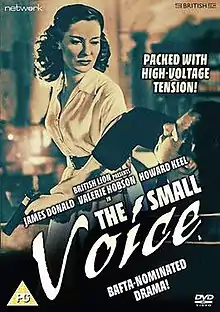The Small Voice
The Small Voice (released in the United States as The Hideout) is a 1948 British thriller film directed by Fergus McDonell and starring Valerie Hobson, James Donald and Howard Keel (who was credited as Harold Keel). The film is part of a group of British film noir produced around this time.[2]
| The Small Voice | |
|---|---|
 | |
| Directed by | Fergus McDonell |
| Produced by | Anthony Havelock-Allan |
| Written by | George Barraud Derek Neame Julian Orde |
| Starring | Valerie Hobson James Donald Howard Keel (as Harold Keel) |
| Music by | Stanley Black |
| Cinematography | Stanley Pavey |
| Edited by | Manuel del Campo |
Production company | Constellation Films |
| Distributed by | British Lion Films |
Release date | 30 November 1948 |
Running time | 85 minutes |
| Country | United Kingdom |
| Language | English |
| Box office | £105,199 (UK)[1] |
The film's sets were designed by the art director Andrew Mazzei. It was the film debut of Howard Keel who made it while appearing in the original London production of Oklahoma![3]
The film received a BAFTA nomination for Best British Film in 1949.[4]
The "small voice" of the title is referred to at the end of the film: the small voice in your own head, of one's conscience telling one not to do something.
Plot
Mr and Mrs Byrne bicker as they drive along a quiet Welsh country road at night. He has lost a leg in the war, and they have drifted apart. She thinks they should separate.
They stop at a police road block who are looking for three escaped convicts. Five minutes later they spot broken glass and a missing parapet on an awkward bend and he goes to investigate. A man comes up the dark embankment and says there are two others in the car. The couple take them to their house, which is only a mile away, and intend to phone for medical assistance.[5]
Two convicts return to their house and area greeted by their Welsh housekeeper. Ms Potter. The injured man is tended in the kitchen but the first man disappears and steals their car. They are immediately suspicious and the injured man pulls a gun.
Back at the crash scene the first convict locates the third man and it is revealed that they hit another car. They search and find the car. The chauffeur is dead but two children are cowering in the back seat. They take the children back to the house.
Mr and Mrs are locked in one room together and joke about the irony. The children are locked in a room with Ms Potter.
The parents are at a police station trying to locate the missing car and children.
The next day the Sunday newspaper arrives and we are told that they have killed a policeman.
The well-educated children start correcting the convicts on their grammar. Ms Potter distracts the convicts while Mrs Byrne escapes from an upper window. She is caught by the gang leader. He later explains to Mr Byrne that he was born in Liverpool but raised in Chicago. He was in prison for killing an officer in his regiment.
The boy appears to have meningitis.The gang leader cannot stand the screaming and goes to shoot him. Mr Byrne finds an unattended gun and goes to shoot the leader. But he leaves the safety carch on. The leader points out the error allowing Mr Byrne to kill him, ending the affair.
Cast
- Valerie Hobson as Eleanor Byrne
- James Donald as Murray Byrne
- Howard Keel (credited as Harold Keel) as Boke
- David Greene as Jim
- Michael Balfour as Frankie
- Joan Young as Mrs Potter, the housekeeper
- Angela Fouldes as Jenny Moss. The credits in the film list her as Angela Faulds
- Glyn Dearman as Ken Moss
- Norman Claridge as Superintendent
- Edward Evans as Police Inspector
- Bill Shine as Maitland
- Michael Hordern as Dr. Mennell
- Edward Palmer as Joe Wallis
- Lyn Evans as Ticket Collector
Critical reception
Virginia Graham wrote in The Spectator in 1948, "all this is admirably done, and eventually provides melodrama of an order as English and as excellent as muffins";[6] while TV Guide concluded that "the tension is sustained throughout, with some interesting plot twists along the way."[7]
References
- Vincent Porter, 'The Robert Clark Account', Historical Journal of Film, Radio and Television, Vol 20 No 4, 2000 p486
- Mayer p.97
- "Annie's Handsome Man". The Sunday Herald. Sydney. 18 June 1950. p. 4 Supplement: Features. Retrieved 17 July 2012 – via National Library of Australia.
- http://awards.bafta.org/award/1949/film. Retrieved 12 February 2020.
- The Small Voice at TCMDB
- "The Hideout (The Small Voice) (1948)" – via www.rottentomatoes.com.
- "Hideout | TV Guide". TVGuide.com.
Bibliography
- Mayer, Geoff. Roy Ward Baker. Manchester University Press, 2004.
External links
- The Small Voice at IMDb
- Review of film at Variety